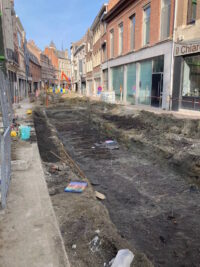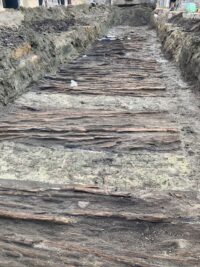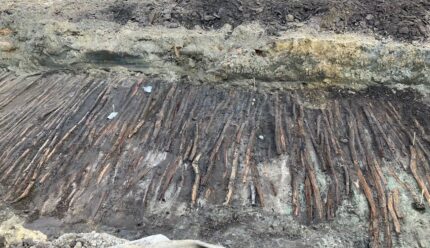 The wooden foundations of a 15th century road have been unearthed in Lier, a city on the outskirts of Antwerp, Belgium. The wood road emerged from under a modern street during city sewer works earlier this month. The original sewers were built in the 1930s and by happy coincidence they were installed next to the medieval street instead of over it or crossing it, so the road was not exposed or damaged at that time.
The wooden foundations of a 15th century road have been unearthed in Lier, a city on the outskirts of Antwerp, Belgium. The wood road emerged from under a modern street during city sewer works earlier this month. The original sewers were built in the 1930s and by happy coincidence they were installed next to the medieval street instead of over it or crossing it, so the road was not exposed or damaged at that time.
The town of Lier grew around the hermitage of its most famous son, the 8th century saint Gummarus, on the banks of the Nete River. Settlements around the hermitage were destroyed in 9th century Norman raids, but the the relics and chapel of St. Gummarus made it a site of pilgrimage, drawing permanent construction and residents to the area. The earliest historical references to what would become Lier date to 970 A.D. The oldest surviving building is the Romanesque St. Peter’s Chapel, originally built in the 13th century. The medieval city center is located at the confluence of the Grote Nete (Big Nete) and Kleine Nete (Little Nete) where the two rivers come together to form the Nete. It was granted official municipal status in 1212, and by the end of that century it was a regionally important center of the textile trade.
 Jan II, Duke of Brabant, gave the city the right to host a cattle market in 1309 and 30 years after that Lier was granted the right to host a cloth market as well. By the end of the 14th century, Lier’s cloth industry had expanded into an international trade. When the road was built in the 15th century, the focus of downtown Lier’s infrastructure had shifted from the earlier medieval religious structures — the hermitage, church, beguinage — to the economic and industrial — merchant halls, quays, bridges, roads.
Jan II, Duke of Brabant, gave the city the right to host a cattle market in 1309 and 30 years after that Lier was granted the right to host a cloth market as well. By the end of the 14th century, Lier’s cloth industry had expanded into an international trade. When the road was built in the 15th century, the focus of downtown Lier’s infrastructure had shifted from the earlier medieval religious structures — the hermitage, church, beguinage — to the economic and industrial — merchant halls, quays, bridges, roads.
The street was known from 16th century maps, but because in the Middle Ages the roads were made from perishable wood rather than the stone of far more ancient Roman roads, nobody expected to find any surviving remains. In this case, the wood was preserved by a thick layer of clay from alluvial deposits.
Archaeologists will now document the wooden foundations. “The new sewerage system will be installed under the road. These are not valuable objects in themselves and as soon as you start digging them up, they disintegrate,” Mayor Verwaest explained. He is keen to assure us that “everything has been inventorised, measured and photographed”.

From wood to cobblestone to asphalted roads, the Saint Gummarus inspired parishioners of Lier are come a long way. Out there, their 300 years old Lier Vlaaike, a spicy pastry made with candy syrup and four spices continues to grow in its appeal across the province of Antwerp.